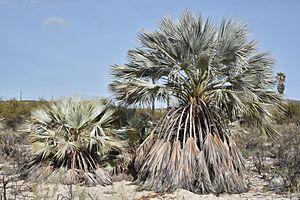Mexican blue palm facts for kids
Quick facts for kids Mexican blue palm |
|
|---|---|
 |
|
| In habitat | |
| Scientific classification | |
| Genus: |
Brahea
|
| Species: |
armata
|
| Synonyms | |
|
|
The Mexican blue palm (also called blue hesper palm) is a tall, evergreen tree. It belongs to the palm family, Arecaceae. This tree naturally grows only in Baja California, Mexico. People often plant it in gardens because it looks very nice.
Contents
Description
This palm tree can grow up to 15 meters (about 50 feet) tall. It has a strong, thick trunk.
Its leaves are a special bluish color. They are very wide, about 1 to 2 meters (3 to 6 feet) across. Each leaf has a long stem called a petiole, which can be 1 meter (3 feet) long. The leaves stay on the tree for a long time. In nature, they form a shaggy layer around the trunk. But when people grow these palms, they usually cut or burn off the old leaves.
The palm also grows long flower stalks, called inflorescences. These can reach up to 5 meters (16 feet) in length, extending far beyond the leaves. The flowers are small and bloom in February and March. After the flowers, the tree grows fruits. These fruits are brown, round or egg-shaped, and about 18 to 24 millimeters (0.7 to 0.9 inches) long.
Where It Grows
This special palm tree is found only in the Mexican state of Baja California. You can see it from just south of the Mexico–United States border near the Jacumba Mountains. It also grows in the Central Desert and on Isla Angel de la Guarda.
You can often find these palms growing in dry riverbeds called arroyos and at the bottom of canyons. They can even grow in cracks in rocks high up in the mountains. Sometimes, they grow alongside other types of palm trees, like Washingtonia filifera or Washingtonia robusta.
Uses
The Mexican blue palm is very popular for planting in gardens. It looks especially pretty when it is young. You can often find it in plant nurseries in the American Southwest and other warm places. In the UK, it has won an award for being a great garden plant.
This palm tree does not need a lot of water, so it is good for dry areas. However, it's a good idea to water it deeply sometimes. It can grow in both partial shade and full sun. It can also handle cold temperatures down to about -10 degrees Celsius (14 degrees Fahrenheit).
This palm is known by several names, including "Mexican blue palm," "blue hesper palm," "big blue hesper palm," "blue fan palm," "sweet brahea," and "palma blanca."
The Cocopah people, who are Native Americans, used to eat the seeds of this palm. They would roast the seeds first.
- Cultivated plants
Images for kids
See also
 In Spanish: Brahea armata para niños
In Spanish: Brahea armata para niños







